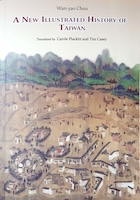kuniga.me > Books > A New Illustrated History of Taiwan
A New Illustrated History of Taiwan

Book by Dr. Wan-yao Chou. I bought this book during a trip to Taiwan. It covers the history of the island from early days until recent times.
Taiwan has been inhabited by Taiwanese aborigines for over thousands of years and they’re related to the Austronesian ethnicity. One theory is that Taiwan is the homeland of Austronesian people, whose language is nowadays spoke all over the Pacific, including the Philippines, Indonesia, Malaysia, Madagascar, and also Hawaiian and Maori.
The Dutch settled there as a basis for the VOC (Verenigde Oostindische Compagnie), but only in Anping (Tainan). They actually encouraged Chinese settlers to move. Most came from Southern China, e.g. the Fukien province (Holo and Hakka subgroups) and spoke Hakka.
During the rise of the Ming dynasty, a loyalist from the Ming dynasty, Zheng Chenggong (Koxinga) moved to the island and eventually expelled the Dutch. The Qing dynasty eventually managed to annex the island.
One day some Okinawans shipwrecked in Taiwan and got killed by aboriginals (Mudan incident), in 1871. After annexing Okinawa 1872, Japan invaded the island and subjugated the eastern tribes Kuskus and Mutan as punishment. This act served to show that Okinawa was not under protectorship of Japan and it also led to the eventual occupation and colonization of Taiwan.
Japan colonized Taiwan from the end of the First Sino-Japanese War until the end of World War II. After that, the Republic of China (ROC), took control of Taiwan. The ruling party, the Kuomintang (KMT) eventually lost the civil war and fled to the country. One interesting bit is that Kai-shek had removed many impertial artifacts from the capital Beijing to protect it from Japanese invaders, but instead of returning them after WWII, he took them to Taiwan and housed them in the National Palace Museum.
The KMT imposed Mandarin Chinese as the national language of Taiwan in detriment of other dialects such as Hokkien and Hakka and indigenous languages.
Overall excellent book with many illustrations and old photos.